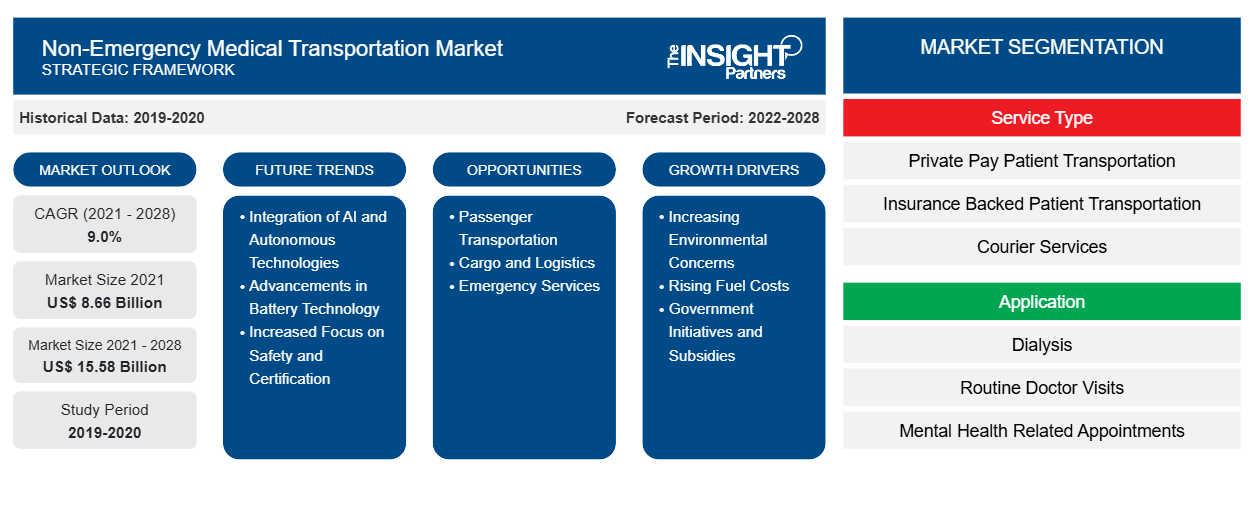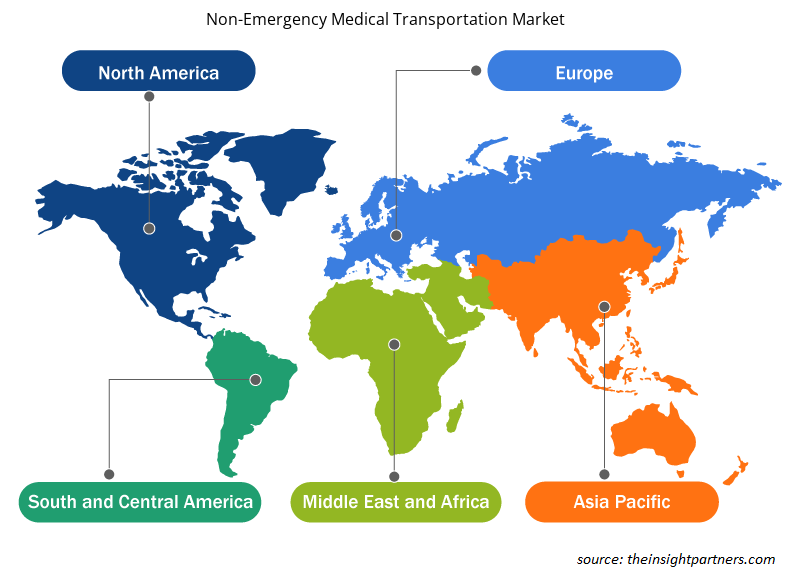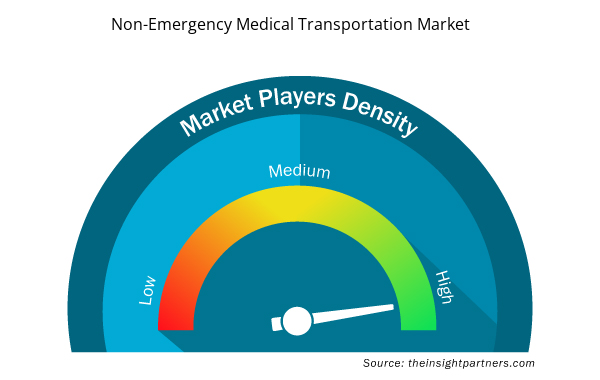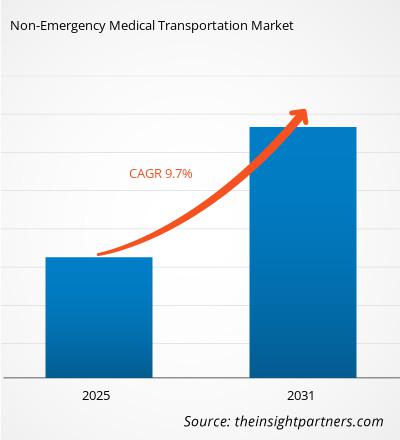비응급 의료 수송 시장 규모는 2024년 167억 1,480만 달러에서 2031년 318억 7,249만 달러로 성장할 것으로 예상됩니다. 2025년부터 2031년까지 연평균 성장률 9.7%를 기록할 것으로 예상됩니다. 비응급 의료 수송 분야의 기술 발전은 향후 몇 년 동안 시장에 새로운 트렌드를 가져올 것으로 예상됩니다.
비응급 의료 운송 시장 분석
비응급 의료 운송 시장을 견인하는 요인 으로는 비응급 의료 운송 수요 증가와 고령 인구의 만성 질환 발생률 급증이 있습니다. 또한, 비응급 의료 운송 분야의 기술 발전이 시장 성장에 기여할 것으로 예상됩니다. 시장 참여자들의 전략적 계획은 향후 몇 년간 풍부한 기회를 창출할 것으로 예상됩니다.
비응급 의료 운송 시장 개요
북미는 비응급 의료 수송 시장을 장악할 것으로 예상되며, 아시아 태평양은 노인층의 만성 질환 유병률 증가와 향상된 의료 솔루션에 대한 수요 증가로 인해 상당한 성장률을 기록할 것으로 예상됩니다. 증가하는 의료 지출과 의료 인프라의 개발, 의료 관광의 급증으로 이 지역의 비응급 의료 수송 수요도 증가했습니다. APAC 에서 중국은 주요 시장 점유율을 차지하고 있으며 인도는 이 지역에서 상당한 성장률을 기록합니다. 중국은 향후 몇 년 동안 의료 기술 혁신을 더욱 발전시키기 위해 1조 5천억 달러를 투자할 계획입니다. 건강한 중국 2030 계획 외에도 이 지출은 기술 발전과 의료 시스템 개선을 통해 중국 내 건강 형평성을 보장하기 위한 것입니다. 민정부와 중국 고령화 국가위원회의 보고서에 따르면 중국은 세계에서 가장 고령화 인구가 많은 나라 중 하나입니다. 2023년에는 60세 이상 인구가 2억 9,700만 명을 넘어 전체 인구의 21.1%를 차지했습니다 . 중국의 고령 인구는 만성 질환 으로 인한 부담이 증가하고 있으며, 고령화는 질병 발생의 주요 위험 요인입니다. BMJ 저널 에 2024년에 발표된 "중국 만성 질환에 대한 미충족 수요(Unmet Needs for Chronic Diseases in China)" 연구에 따르면, 비전염성 질환( NCD )은 중국에서 가장 심각한 건강 위협으로, 전체 사망의 91%를 차지합니다. 중국의 주요 비전염성 질환 에는 심혈관 질환(43%), 암(23%), 당뇨병(2%)이 포함 됩니다 .
귀하의 요구 사항에 맞게 이 보고서를 사용자 정의하세요
이 보고서의 일부 또는 국가 수준 분석, Excel 데이터 팩을 포함하여 모든 보고서에 대한 사용자 정의를 무료로 받을 수 있으며, 신생 기업 및 대학을 위한 훌륭한 혜택과 할인도 이용할 수 있습니다.
비응급 의료 운송 시장:

- 이 보고서에서 주요 시장 동향을 알아보세요.이 무료 샘플에는 시장 동향부터 추정치 및 예측까지 다양한 데이터 분석이 포함됩니다.
비응급 의료 운송 시장 동인 및 기회
비응급 의료 수송에 대한 수요 증가
미국병원협회(American Hospital Association)에 따르면, 미국에서는 매년 약 360만 명이 교통 문제(차량 접근성 부족, 의료 시설까지의 먼 거리, 대중교통 인프라 부족, 교통비)로 인해 필요한 의료 서비스를 받지 못하고 있습니다. UC 데이비스 헬스(UC Davis Health)의 연구에 따르면, 매년 약 580만 명의 미국인이 교통 문제로 인해 진료를 받지 못하거나 지연되는 것으로 나타났습니다. 교통은 진료 예약 미이행의 중요한 요인입니다. 카이저 퍼머넌트(Kaiser Permanente ) 의 2019년 설문 조사에 따르면 미국인의 3분의 1이 교통 문제로 인해 자주 또는 가끔 스트레스를 받는 것으로 나타났습니다.
1965년부터 메디케이드는 비응급 의료 이송( NEMT ) 혜택을 제공해 왔으며, 메디케이드 가입자는 필수 혜택으로 이송 서비스를 제공받습니다. 메디케이드 등록 및 해지 추적(Medicaid Enrollment and Unwinding Tracker)에 따르면 2023년 4월까지 총 약 9,400만 명이 메디케이드에 등록되었습니다. KFF 메디케이드 예산 조사는 2021년 미국에서 의료 서비스 가입자가 8.2% 증가할 것으로 예상했는데, 이는 주로 코로나19 사태와 실업률 증가에 따른 것입니다. 더 많은 사람들이 메디케이드에 가입함에 따라 NEMT 서비스 에 대한 수요가 직접적으로 증가하고 있습니다 .
미국 대부분의 주에서는 NEMT 브로커나 관리 의료 기관(MCO)을 통해 NEMT를 제공하는 방식으로 전환했습니다. 많은 주에서 브로커나 MCO는 NEMT 서비스를 감독하기 위해 1인당 수수료를 받는 반면, 네바다, 애리조나, 버몬트 등 다른 주에서는 지역 서비스 제공업체를 통해 행위별 수가제로 NEMT를 제공합니다. 아동 건강 보험 프로그램(CHIP)은 메디케이드와 별도의 CHIP 프로그램을 통해 자격을 갖춘 아동에게 건강 보험을 제공합니다. CHIP는 연방 정부의 요건에 따라 주에서 관리하며, 주 정부와 연방 정부가 공동으로 자금을 지원합니다. 따라서 정부의 이러한 정책이 증가함에 따라 NEMT에 대한 수요가 증가하고 있으며, 이는 시장 성장을 촉진하고 있습니다.
NEMT와 교통망 회사의 전략적 이니셔티브는 시장 성장을 위한 풍부한 기회를 창출합니다.
NEMT 기업과 교통망 기업(TNC)은 의료 서비스 접근성을 개선하기 위한 전략적 조치를 적극적으로 추진하고 있습니다. Uber나 Lyft와 같은 TNC는 주문형 차량 호출 기능과 사용자 친화적인 모바일 앱으로 유명합니다. 이러한 기능은 NEMT 서비스와 관련된 가용성 및 일정 문제를 효과적으로 해결할 수 있습니다. 다양한 TNC는 현재 새로운 플랫폼을 개발 중이거나 전 세계 NEMT 및 개별 의료 서비스 제공업체와 협력하고 있습니다. 여러 주 정부 기관은 TNC의 NEMT 서비스 제공을 허용하고 있습니다. 몇 가지 예를 아래에 소개합니다.
- 2024년 6월, 우버는 환자의 진료 예약 시간 준수를 지원하는 플랫폼인 우버 헬스(Uber Health)를 공식 출시했습니다. 이 플랫폼은 노쇼(No-show)를 줄이고 정시성을 향상하는 데 도움이 될 것입니다. 이 이니셔티브는 HIPAA를 준수하며 기존 택시 서비스에 비해 비용 효율적인 대안을 제시하며, 특히 전담 운송 자원이 부족한 소규모 의료 기관에 큰 도움이 됩니다. 미국 250개 이상의 도시에서 서비스를 제공하는 우버의 의료 중심 플랫폼은 NEMT(전국 의료 서비스) 접근성을 크게 확대합니다.
- 2024년 1월, CTG 파트너사인 MediDrive가 NEMT 시장에 공식 진출했습니다. MediDrive는 환자를 진료 예약 및 시술 장소로 이동시키는 복잡한 과정을 해결하는 데 전념하고 있습니다.
- 2022년 6월, MTM은 선제적인 여행 관리 서비스를 제공하기 위해 Elevate 프로그램을 출시했습니다. MTM은 Elevate 프로그램 회원들의 여행을 선제적으로 관리하며, 복잡한 여정에 대한 컨시어지 수준의 서비스를 제공하고 회원들의 고유한 교통 요구를 충족합니다.
- 2022년 2월, Modivcare Inc.는 Modivcare Academy를 출범했습니다. 이 혁신적인 프로그램은 교육 자료, 네트워킹 기회, 그리고 교육을 제공하여 NEMT(북미 중부 산악 지역) 지역 운송 서비스 제공업체를 지원하는 것을 목표로 합니다. 이 프로그램은 운송 서비스 제공업체에게 필수적인 비즈니스 도구, 모범 사례, 그리고 교육을 제공하여 미국에서 가장 취약한 계층의 돌봄을 효과적으로 지원합니다.
이러한 전략적 이니셔티브는 서비스 효율성 향상, 환자 접근성 향상, 운영 비용 절감, 그리고 의료 서비스와의 더욱 원활한 통합에 중점을 둡니다. NEMT(전국 의료장비) 부문이 지속적으로 성장함에 따라, 이러한 이니셔티브는 전 세계적으로 서비스를 확대하고 환자 진료의 질을 향상시키는 데 매우 중요할 것입니다.
비응급 의료 운송 시장 보고서 세분화 분석
비응급 의료 운송 시장 분석에 기여한 주요 세그먼트는 서비스 유형, 시설, 응용 프로그램 및 최종 사용자입니다.
- 비응급 의료 수송 시장은 서비스 유형에 따라 개인 부담 환자 수송, 보험 적용 환자 수송, 택배 서비스 등으로 세분화됩니다. 개인 부담 환자 수송 부문은 2024년 시장 점유율 1위를 차지했으며, 2024년부터 2031년까지 가장 높은 연평균 성장률(CAGR)을 기록할 것으로 예상됩니다.
- 비응급 의료 수송 시장은 시설별로 시설 내 수송과 시설 간 수송으로 구분됩니다. 시설 간 수송 부문은 2024년에 시장 점유율이 더 높았으며, 2024년부터 2031년까지 연평균 성장률(CAGR)이 더 높을 것으로 예상됩니다.
- 비응급 의료 수송 시장은 투석, 정기 진료, 정신 건강 관련 진료, 재활 등으로 세분화됩니다. 정신 건강 관련 진료 부문은 2024년 시장 점유율이 가장 높았으며, 재활 부문은 2024년부터 2031년까지 가장 높은 연평균 성장률을 기록할 것으로 예상됩니다.
- 최종 사용자 측면에서 비응급 의료 수송 시장은 병원 및 진료소, 요양원, 재택 치료 시설, MCO 및 주 정부 기관, 의료비 지불 기관 등으로 세분화됩니다. 병원 및 진료소 부문은 2024년에 시장을 장악했으며, 요양원 부문은 2024년부터 2031년까지 가장 높은 연평균 성장률을 기록할 것으로 예상됩니다.
지역별 비응급 의료 운송 시장 점유율 분석
비응급 의료 운송 시장 보고서의 지리적 범위는 주로 북미, 아시아 태평양, 유럽, 중동 및 아프리카, 남미 및 중미의 5개 지역으로 나뉩니다.
북미는 2023년 시장에서 상당한 점유율을 차지했습니다. 비응급 의료 운송 시장의 성장은 다양한 질병의 유병률 증가, 비응급 의료 운송(NEMT)에 대한 보험 적용 확대, 그리고 이러한 서비스에 대한 주 정부의 높은 행정 또는 의료비 상환율에 기인합니다. 또한, 환자 중심 치료로의 전환, NEMT에 대한 인식 제고, 그리고 기술 발전 또한 시장 성장을 뒷받침하는 요인입니다. 만성 질환, 고령, 장애, 부상, 비만은 미국인들이 비응급 의료 운송 서비스에 의존하는 여러 이유 중 일부에 불과합니다. 팬데믹으로 인해 진료 예약, 필수적인 병원 방문, 그리고 일상적인 치료를 위해 신뢰할 수 있는 차량 운송에 대한 수요가 크게 증가했습니다. 또한, 고령 인구 증가는 미국 내 비응급 의료 운송 시장 성장에 기여하고 있습니다. 또한, 이 시장에서 활동하는 기업들은 시장 확장을 위해 유기적 및 비유기적 개발 전략을 채택하고 있습니다. 다음은 이러한 전략의 몇 가지 사례입니다.
- 매사추세츠에 본사를 둔 민간 의료 운송 회사인 코스탈 메디컬 트랜스포테이션 시스템즈(Coastal Medical Transportation Systems, CMTS)는 2022년 9월, Transformative Healthcare의 의료 운송 사업부를 인수했습니다. 이 사업부에는 LifeLine Ambulance Service와 Fallon Ambulance Service가 포함되었습니다. 이 인수를 통해 CMTS는 환자 수와 서비스 지역 측면에서 매사추세츠 주 최대 규모의 구급차 네트워크 중 하나가 되었습니다.
- 2022년 9월, 베이스테이트 윙 병원은 매사추세츠 주에서 의료 서비스를 제공하기 위해 콰보그 커넥터(Quaboag Connector)와 제휴했습니다. 이 커브 투 커브(curb-to-curb) 서비스는 NEMT(신경계 손상)를 제공하여 환자가 베이스테이트 윙 병원 진료 예약 장소까지 이동 서비스를 요청할 수 있도록 합니다.
비응급 의료 운송 시장 지역 통찰력
Insight Partners의 분석가들은 예측 기간 동안 비응급 의료 운송 시장에 영향을 미치는 지역별 동향과 요인을 면밀히 분석했습니다. 이 섹션에서는 북미, 유럽, 아시아 태평양, 중동 및 아프리카, 그리고 중남미 지역의 비응급 의료 운송 시장 부문과 지역별 현황도 살펴봅니다.

- 비응급 의료 운송 시장에 대한 지역별 데이터 가져오기
비응급 의료 운송 시장 보고서 범위
| 보고서 속성 | 세부 |
|---|---|
| 2024년 시장 규모 | 167억 1,480만 달러 |
| 2031년까지 시장 규모 | 31,872.49백만 달러 |
| 글로벌 CAGR(2025~2031년) | 9.7% |
| 역사적 데이터 | 2021-2023 |
| 예측 기간 | 2025-2031 |
| 다루는 세그먼트 | 서비스 유형별
|
| 포함된 지역 및 국가 | 북아메리카
|
| 시장 선도 기업 및 주요 회사 프로필 |
|
비응급 의료 운송 시장 참여자 밀도: 비즈니스 역학에 미치는 영향 이해
비응급 의료 운송 시장은 소비자 선호도 변화, 기술 발전, 그리고 제품 효능에 대한 인식 제고 등의 요인으로 인한 최종 사용자 수요 증가에 힘입어 빠르게 성장하고 있습니다. 수요가 증가함에 따라 기업들은 제품 및 서비스를 확장하고, 소비자 니즈를 충족하기 위한 혁신을 추진하며, 새로운 트렌드를 적극 활용하고 있으며, 이는 시장 성장을 더욱 가속화하고 있습니다.
시장 참여자 밀도는 특정 시장이나 산업 내에서 활동하는 기업들의 분포를 나타냅니다. 이는 특정 시장 공간에 얼마나 많은 경쟁자(시장 참여자)가 존재하는지를 규모나 전체 시장 가치 대비로 나타냅니다.
비응급 의료 운송 시장에서 운영되는 주요 회사는 다음과 같습니다.
- 주식회사 엠티엠
- 암르
- 익스프레스 운송
- CJ 메디컬 운송
- 베리다
면책 조항 : 위에 나열된 회사는 특정 순서에 따라 순위가 매겨지지 않았습니다.

- 비응급 의료 운송 시장의 주요 업체 개요를 확인하세요.
비응급 의료 운송 시장 뉴스 및 최근 동향
비응급 의료 수송 시장은 1차 및 2차 조사 이후 주요 기업 간행물, 협회 데이터, 데이터베이스 등 정성적 및 정량적 데이터를 수집하여 평가합니다. 비응급 의료 수송 시장의 몇 가지 동향은 다음과 같습니다.
- Modivcare Inc.는 NEMT 혜택을 받는 Medicaid 및 Medicare 회원의 참여와 경험을 혁신하는 획기적인 디지털 플랫폼인 Integration Hub를 출시했습니다. Modivcare의 Integration Hub는 업계 최초로 확장 가능한 모듈형 모빌리티 플랫폼을 제공하며, 이를 통해 상업 건강 보험 고객, 주 Medicaid 기관 및 시설 파트너에게 개방형 애플리케이션 프로그래밍 인터페이스(API)를 제공합니다. (출처: ModivCare, 회사 웹사이트, 2024년 5월)
- 미국 최대 규모의 비상장 NEMT 브로커인 MTM은 글로벌 메디컬 리스폰스(Global Medical Response)와 액세스투케어(Access2Care, LLC) 인수 계약을 체결했습니다. 이 전략적 인수를 통해 MTM은 시장 입지를 크게 강화하고 연간 총 매출을 증가시켜 회사 성장 궤도에 중요한 이정표를 세웠습니다. 액세스투케어의 NEMT 사업 인수는 신중한 검토 끝에 이루어졌으며, MTM의 전략적 확장 계획과 부합합니다. (출처: MTM, Inc., 회사 웹사이트, 2024년 8월)
- 아카디안 앰뷸런스 서비스(Acadian Ambulance Service)는 텍사스주 뉴브라운펠스에 본사를 둔 응급 의료 서비스(EMS) 제공업체인 서던크로스 앰뷸런스(SouthernCross Ambulance)의 자산을 실질적으로 모두 인수하는 계약을 체결했다고 발표했습니다. 이번 인수를 통해 아카디안은 구급차 12대와 휠체어 밴 10대를 추가로 운영하고 신규 직원을 채용할 수 있게 되었습니다. 서던크로스 앰뷸런스는 남중부 및 남부 텍사스 지역에 응급 및 비응급 구급차 운송 서비스를 제공하며, 병원, 재활 센터, 진료소, 요양원, 전문 간호 센터를 오가는 지역 및 장거리 구급차 운송 서비스를 제공합니다. (출처: 아카디안 앰뷸런스 서비스, 회사 웹사이트, 2024년 1월)
비응급 의료 운송 시장 보고서 범위 및 성과물
"비응급 의료 운송 시장 규모 및 예측(2021~2031)" 보고서는 아래 영역을 포괄하여 시장에 대한 자세한 분석을 제공합니다.
- 범위에 포함된 모든 주요 시장 부문에 대한 글로벌, 지역 및 국가 수준의 비응급 의료 운송 시장 규모 및 예측
- 비응급 의료 운송 시장 동향 및 운전자, 제지 장치 및 주요 기회와 같은 시장 역학
- 자세한 PEST 및 SWOT 분석
- 주요 시장 동향, 글로벌 및 지역 프레임워크, 주요 참여자, 규정 및 최근 시장 개발을 다루는 비응급 의료 운송 시장 분석
- 비응급 의료 운송 시장의 시장 집중도, 히트맵 분석, 주요 업체 및 최근 개발 사항을 다루는 산업 환경 및 경쟁 분석
- 자세한 회사 프로필
- 역사적 분석(2년), 기준 연도, CAGR을 포함한 예측(7년)
- PEST 및 SWOT 분석
- 시장 규모 가치/양 - 글로벌, 지역, 국가
- 산업 및 경쟁 환경
- Excel 데이터 세트


- Trade Promotion Management Software Market
- Online Exam Proctoring Market
- Intraoperative Neuromonitoring Market
- Hydrocephalus Shunts Market
- Grant Management Software Market
- Battery Testing Equipment Market
- Industrial Valves Market
- USB Device Market
- Flexible Garden Hoses Market
- Customer Care BPO Market

Report Coverage
Revenue forecast, Company Analysis, Industry landscape, Growth factors, and Trends

Segment Covered
This text is related
to segments covered.

Regional Scope
North America, Europe, Asia Pacific, Middle East & Africa, South & Central America

Country Scope
This text is related
to country scope.
자주 묻는 질문
The global non-emergency medical transportation market is estimated to register a CAGR of 9.7% during the forecast period.
The estimated value of the non-emergency medical transportation market can reach US$ 31,872.49 million by 2031.
North America dominated the non-emergency medical transportation market in 2024.
The increasing increasing need for non-emergency medical transportation and surging incidence of chronic conditions among aging populations. arethe most influential factors responsible for the market growth.
MTM, Inc.; AMR; Xpress Transportation; CJ Medical Transportation; VERIDA; ModivCare; Crothall Healthcare; Elite Medical Transport; Acadian Ambulance Service; Transdev; Ride Health; Roundtrip; Medical Answering Services, LLC; One Call; Stellar Transport; Abba Medical Transportation, LLC; Able Medical Transportation, Inc.; Life Ride; Mobility Transportation Services, Inc.; and ABC Non-Emergency Medical Transportation, LLC are among the key players operating in the non-emergency medical transportation market.
Trends and growth analysis reports related to Life Sciences : READ MORE..
The List of Companies - Non-Emergency Medical Transportation Market
- MTM, Inc.
- AMR
- Xpress Transportation
- CJ Medical Transportation
- VERIDA
- ModivCare
- Crothall Healthcare
- Elite Medical Transport
- Acadian Ambulance Service
- Transdev
- Ride Health
- Roundtrip
- Medical Answering Services, LLC
- One Call
- Stellar Transport
- Abba Medical Transportation, LLC
- Able Medical Transportation, Inc.
- Life Ride
- Mobility Transportation Services, Inc.
- ABC Non-Emergency Medical Transportation, LLC
The Insight Partners performs research in 4 major stages: Data Collection & Secondary Research, Primary Research, Data Analysis and Data Triangulation & Final Review.
- Data Collection and Secondary Research:
As a market research and consulting firm operating from a decade, we have published and advised several client across the globe. First step for any study will start with an assessment of currently available data and insights from existing reports. Further, historical and current market information is collected from Investor Presentations, Annual Reports, SEC Filings, etc., and other information related to company’s performance and market positioning are gathered from Paid Databases (Factiva, Hoovers, and Reuters) and various other publications available in public domain.
Several associations trade associates, technical forums, institutes, societies and organization are accessed to gain technical as well as market related insights through their publications such as research papers, blogs and press releases related to the studies are referred to get cues about the market. Further, white papers, journals, magazines, and other news articles published in last 3 years are scrutinized and analyzed to understand the current market trends.
- Primary Research:
The primarily interview analysis comprise of data obtained from industry participants interview and answers to survey questions gathered by in-house primary team.
For primary research, interviews are conducted with industry experts/CEOs/Marketing Managers/VPs/Subject Matter Experts from both demand and supply side to get a 360-degree view of the market. The primary team conducts several interviews based on the complexity of the markets to understand the various market trends and dynamics which makes research more credible and precise.
A typical research interview fulfils the following functions:
- Provides first-hand information on the market size, market trends, growth trends, competitive landscape, and outlook
- Validates and strengthens in-house secondary research findings
- Develops the analysis team’s expertise and market understanding
Primary research involves email interactions and telephone interviews for each market, category, segment, and sub-segment across geographies. The participants who typically take part in such a process include, but are not limited to:
- Industry participants: VPs, business development managers, market intelligence managers and national sales managers
- Outside experts: Valuation experts, research analysts and key opinion leaders specializing in the electronics and semiconductor industry.
Below is the breakup of our primary respondents by company, designation, and region:

Once we receive the confirmation from primary research sources or primary respondents, we finalize the base year market estimation and forecast the data as per the macroeconomic and microeconomic factors assessed during data collection.
- Data Analysis:
Once data is validated through both secondary as well as primary respondents, we finalize the market estimations by hypothesis formulation and factor analysis at regional and country level.
- Macro-Economic Factor Analysis:
We analyse macroeconomic indicators such the gross domestic product (GDP), increase in the demand for goods and services across industries, technological advancement, regional economic growth, governmental policies, the influence of COVID-19, PEST analysis, and other aspects. This analysis aids in setting benchmarks for various nations/regions and approximating market splits. Additionally, the general trend of the aforementioned components aid in determining the market's development possibilities.
- Country Level Data:
Various factors that are especially aligned to the country are taken into account to determine the market size for a certain area and country, including the presence of vendors, such as headquarters and offices, the country's GDP, demand patterns, and industry growth. To comprehend the market dynamics for the nation, a number of growth variables, inhibitors, application areas, and current market trends are researched. The aforementioned elements aid in determining the country's overall market's growth potential.
- Company Profile:
The “Table of Contents” is formulated by listing and analyzing more than 25 - 30 companies operating in the market ecosystem across geographies. However, we profile only 10 companies as a standard practice in our syndicate reports. These 10 companies comprise leading, emerging, and regional players. Nonetheless, our analysis is not restricted to the 10 listed companies, we also analyze other companies present in the market to develop a holistic view and understand the prevailing trends. The “Company Profiles” section in the report covers key facts, business description, products & services, financial information, SWOT analysis, and key developments. The financial information presented is extracted from the annual reports and official documents of the publicly listed companies. Upon collecting the information for the sections of respective companies, we verify them via various primary sources and then compile the data in respective company profiles. The company level information helps us in deriving the base number as well as in forecasting the market size.
- Developing Base Number:
Aggregation of sales statistics (2020-2022) and macro-economic factor, and other secondary and primary research insights are utilized to arrive at base number and related market shares for 2022. The data gaps are identified in this step and relevant market data is analyzed, collected from paid primary interviews or databases. On finalizing the base year market size, forecasts are developed on the basis of macro-economic, industry and market growth factors and company level analysis.
- Data Triangulation and Final Review:
The market findings and base year market size calculations are validated from supply as well as demand side. Demand side validations are based on macro-economic factor analysis and benchmarks for respective regions and countries. In case of supply side validations, revenues of major companies are estimated (in case not available) based on industry benchmark, approximate number of employees, product portfolio, and primary interviews revenues are gathered. Further revenue from target product/service segment is assessed to avoid overshooting of market statistics. In case of heavy deviations between supply and demand side values, all thes steps are repeated to achieve synchronization.
We follow an iterative model, wherein we share our research findings with Subject Matter Experts (SME’s) and Key Opinion Leaders (KOLs) until consensus view of the market is not formulated – this model negates any drastic deviation in the opinions of experts. Only validated and universally acceptable research findings are quoted in our reports.
We have important check points that we use to validate our research findings – which we call – data triangulation, where we validate the information, we generate from secondary sources with primary interviews and then we re-validate with our internal data bases and Subject matter experts. This comprehensive model enables us to deliver high quality, reliable data in shortest possible time.

 이 보고서에 대한 무료 샘플을 받으세요
이 보고서에 대한 무료 샘플을 받으세요